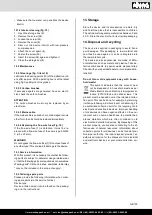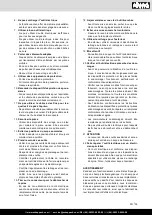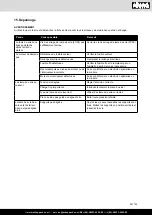
9.4 Speed regulator (fig. 2)
The speed regulator (17) allows you to set the stroke
rate according to the material to be cut. In case of
soft material, we recommend high stroke rates, while
strokes rates should be kept low for hard material.
Turn the speed regulator (17) clockwise to increase
the stroke rate. Turning counterclockwise lowers the
stroke rate.
9.5 Making inside cuts
This scroll saw allows inside cuts in workpieces with-
out damaging the outside or the circumference of the
workpiece.
1. Remove the saw blade (21) as described in 8.2.
2. Drill a hole into the workpiece.
3. Place the workpiece with the drilled hole over the
opening of the table inlay (25) on the saw table (6).
4. Install the saw blade (21) (as described in 8.2)
through the drilled hole in the workpiece and set
the blade tension.
5. After completing the inside cut, remove the saw
blade (21) from the blade holders (as described
in 8.2).
6. Remove the workpiece from the table.
9.6 Carrying out mitre cuts (fig. 14)
WARNING
Be particularly careful when making mitre cuts. The
incline of the saw table supports slipping. There is a
danger of injury.
1. To carry out mitre cuts, adjust the distance be-
tween the saw blade guard (5) mounted to the re-
taining device (23) and the work table accordingly.
2. Swivel the table by loosening the knurled nut (14)
and tilting the saw table (6) into the desired position.
3. Tighten the knurled nut (14).
10. Electrical connection
The electrical motor installed is connected and
ready for operation.
The connection complies
with the applicable VDE and DIN provisions.
The customer‘s mains connection as well as
the extension cable used must also comply with
these regulations.
Damaged electrical connection cable
The insulation on electrical connection cables is of-
ten damaged.
This may have the following causes:
• Pressure points, where connection cables are
passed through windows or doors
• Kinks where the connection cable has been im-
properly fastened or routed
• Places where the connection cables have been cut
due to being driven over
• Insulation damage due to being ripped out of the
wall outlet.
• Cracks due to the insulation ageing.
Such damaged electrical connection cables must not
be used and are life-threatening due to the insulation
damage.
Check the electrical connection cables for damage regu-
larly. Ensure that the connection cables are disconnected
from electrical power when checking for damage.
Electrical connection cables must comply with the
applicable VDE and DIN provisions.
Only use connection cables with the marking H 05 VV-F.
The printing of the type designation on the connec-
tion cable is mandatory.
AC motor
The mains voltage must be 220-240 V~.
Extension cables up to 25 m long must have a cross-
section of 1.5 mm2.
Connections and repair work on the electrical equip-
ment may only be carried out by electricians.
Please provide the following information in the event
of any enquiries:
• Type of current for the motor
• Machine data - type plate
11. Transport
• Transport the electric tool by lifting it on the re-
cesses provided for this on the frame and the mo-
tor cover.
• Never use the protective devices for handling or
transport.
• Make sure that the exposed part of the saw blade
is covered during transport, e.g. by the protective
device.
12. Cleaning, maintenance and
ordering spare parts
WARNING
Always switch the machine off and remove the mains
plug prior to all maintenance and cleaning work.
12.1 Cleaning
Keep protective devices, air vents and the motor
housing as free of dust and dirt as possible. We rec-
ommend cleaning the device directly after every use.
12.1.1 Exterior cleaning
• Clean the device at regular intervals using a damp
cloth and a little soft soap.
• Do not use cleaning agents or solvents. These
could damage the plastic parts of the device.
www.scheppach.com /
+(49)-08223-4002-99 /
+(49)-08223-4002-58
28 | GB
















































